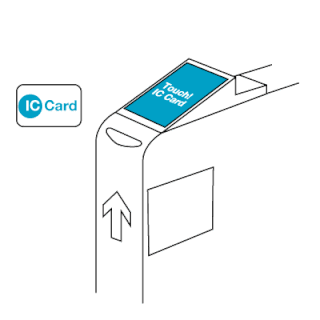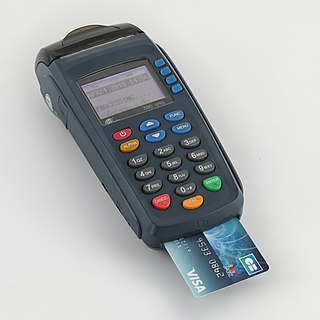Related Research Articles

A mobile payment, also referred to as mobile money, mobile money transfer and mobile wallet, is any of various payment processing services operated under financial regulations and performed from or via a mobile device, as the cardinal class of digital wallet. Instead of paying with cash, cheque, or credit cards, a consumer can use a payment app on a mobile device to pay for a wide range of services and digital or hard goods. Although the concept of using non-coin-based currency systems has a long history, it is only in the 21st century that the technology to support such systems has become widely available.

Near-field communication (NFC) is a set of communication protocols that enables communication between two electronic devices over a distance of 4 cm (1.57 in) or less. NFC offers a low-speed connection through a simple setup that can be used to bootstrap more capable wireless connections. Like other "proximity card" technologies, NFC is based on inductive coupling between two so-called antennas present on NFC-enabled devices—for example a smartphone and a printer—communicating in one or both directions, using a frequency of 13.56 MHz in the globally available unlicensed radio frequency ISM band using the ISO/IEC 18000-3 air interface standard at data rates ranging from 106 to 848 kbit/s.

The EZ-Link card is a rechargeable contactless smart card and electronic money system that is primarily used as a payment method for public transport such as bus and rail lines in Singapore. A standard EZ-Link card is a credit-card-sized stored-value contact-less smart-card that comes in a variety of colours, as well as limited edition designs. It is sold by TransitLink Pte Ltd, a subsidiary of the Land Transport Authority (LTA), and can be used on travel modes across Singapore, including the Mass Rapid Transit (MRT), the Light Rail Transit (LRT), public buses which are operated by SBS Transit, SMRT Buses, Tower Transit Singapore and Go-Ahead Singapore, as well as the Sentosa Express.

MIFARE is a series of integrated circuit (IC) chips used in contactless smart cards and proximity cards.

A contactless smart card is a contactless credential whose dimensions are credit-card size. Its embedded integrated circuits can store data and communicate with a terminal via NFC. Commonplace uses include transit tickets, bank cards and passports.

Network for Electronic Transfers, colloquially known as NETS, is a Singaporean electronic payment service provider. Founded in 1985, by a consortium of local banks, it aims to establish the debit network and drive the adoption of electronic payments in Singapore. It is owned by DBS Bank, OCBC Bank and United Overseas Bank (UOB).

Contactless payment systems are credit cards and debit cards, key fobs, smart cards, or other devices, including smartphones and other mobile devices, that use radio-frequency identification (RFID) or near-field communication for making secure payments. The embedded integrated circuit chip and antenna enable consumers to wave their card, fob, or handheld device over a reader at the Point-of-sale terminal. Contactless payments are made in close physical proximity, unlike other types of mobile payments which use broad-area cellular or WiFi networks and do not involve close physical proximity.

A payment terminal, also known as a point of sale (POS) terminal, credit card machine, PIN pad, EFTPOS terminal, is a device which interfaces with payment cards to make electronic funds transfers. The terminal typically consists of a secure keypad for entering PIN, a screen, a means of capturing information from payments cards and a network connection to access the payment network for authorization.
JVL Ventures, LLC d/b/a Softcard, was a joint venture between AT&T, T-Mobile and Verizon which produced a mobile payments platform known as Softcard, which used near-field communication (NFC) technology to allow users to pay for items at stores and restaurants with credit and debit card credentials stored on their smartphones. The partnership was first announced on November 16, 2010; following a trial period in 2012, the service officially launched nationwide on November 14, 2013. The official Softcard app was available for NFC-compatible smartphones using the Android operating system and later on Windows Phone 8.1.
CIPURSE is an open security standard for transit fare collection systems. It makes use of smart card technologies and additional security measures.

Apple Wallet, is a digital wallet developed by Apple Inc. and included with iOS and watchOS that allows users to store Wallet passes such as coupons, boarding passes, student ID cards, government ID cards, business credentials, resort passes, car keys, home keys, event tickets, public transportation passes, store cards, and – starting with iOS 8.1 – credit cards, debit cards, and prepaid cards for use via Apple Pay.
Bell Identification B.V., or Bell ID, was a Dutch software company that developed smart token management software, including key management, smart card management, EMV data preparation, and host card emulation-based mobile payments software. Bell ID was acquired by Rambus in 2016 and in 2019, Visa Inc. acquired Bell ID from Rambus.
Payanywhere is a payments platform and app that allows merchants in the United States to accept credit and debit card payments while building customer relationships in-store, online, or on the go. Merchants may accept payments on their smartphone via a Bluetooth card reader or on an in-store “Storefront” solution featuring a tablet and stand, which was introduced on April 8, 2014. PayAnywhere offers credit card readers and apps that are compatible with both Apple and Android devices.
Microsoft Pay was a mobile payment and digital wallet service by Microsoft that allowed users to make payments and store loyalty cards on certain mobile devices, as well on PCs using the Microsoft Edge browser. Microsoft Pay does not require Microsoft Pay-specific contactless payment terminals, and supported existing contactless terminals if used on mobile devices. Similar to Android Pay, Microsoft Pay utilized host card emulation (HCE) for making in-store payments.
Apple Pay is a mobile payment service by Apple Inc. that allows users to make payments in person, in iOS apps, and on the web. It is supported on iPhone, Apple Watch, iPad, and Mac. It digitizes and can replace a credit or debit card chip and PIN transaction at a contactless-capable point-of-sale terminal. It does not require Apple Pay-specific contactless payment terminals; it can work with any merchant that accepts contactless payments. It adds two-factor authentication via Touch ID, Face ID, PIN, or passcode. Devices wirelessly communicate with point of sale systems using near field communication (NFC), with an embedded secure element (eSE) to securely store payment data and perform cryptographic functions, and Apple's Touch ID and Face ID for biometric authentication.

Samsung Pay is a mobile payment and digital wallet service by Samsung Electronics that lets users make payments using compatible phones and other Samsung-produced devices. The service supports contactless payments using near-field communications (NFC), but also supports magnetic strip-only payment terminals by incorporating magnetic secure transmission (MST) in devices released before 2021. In India, it also supports bill payments.

LG Pay was a mobile payment and digital wallet service by LG Electronics that let users make payments using compatible phones. The service supported contactless payments using near-field communications (NFC), but also incorporated wireless magnetic communication that allowed contactless payments to be used on payment terminals that only supported magnetic stripe transactions.

Google Pay is a mobile payment service developed by Google to power in-app, online, and in-person contactless purchases on mobile devices, enabling users to make payments with Android phones, tablets, or watches. Users can authenticate via a PIN, passcode, or biometrics such as 3D face scanning or fingerprint recognition.
Square is a financial services platform developed by Block, Inc. It is aimed at small-and medium-size businesses, allowing them to accept credit card payments and use phones or tablets as payment registers for a point-of-sale system.
Google Wallet is a digital wallet platform developed by Google. It is available for the Android, Wear OS, and Fitbit OS operating systems, and was announced on May 11, 2022, at the 2022 Google I/O keynote. It began rolling out on Android smartphones on July 18 while co-existing with the 2020 Google Pay app.
References
- 1 2 3 "Host-based Card Emulation". developer.android.com. Retrieved March 1, 2015.
- ↑ "SimplyTapp Proposes Secure Elements in the Cloud".
- ↑ "IDC: Smartphone OS Market Share". www.idc.com. Retrieved 2015-06-02.
- ↑ "Visa Inc" . Retrieved 2 October 2014.
- ↑ "MasterCard to Use Host Card Emulation (HCE) for NFC-Based Mobile Payments". MasterCard Social Newsroom. Archived from the original on 6 October 2014. Retrieved 2 October 2014.
- ↑ "RBC First bank in North America with Host Card Emulation" . Retrieved 18 December 2014.
- 1 2 "Android KitKat". Android Developers. Google. Retrieved 2 February 2014.
- 1 2 Clark, Sarah. "SimplyTapp proposes secure elements in the cloud". NFC World. Retrieved 2 February 2014.
- ↑ "Windows 10 for mobile gets HCE". nfcworld.com. Retrieved 25 March 2015.
- ↑ "[HOW-TO][CHICAGO] Ventra using SimplyTapp". XDA Developers.